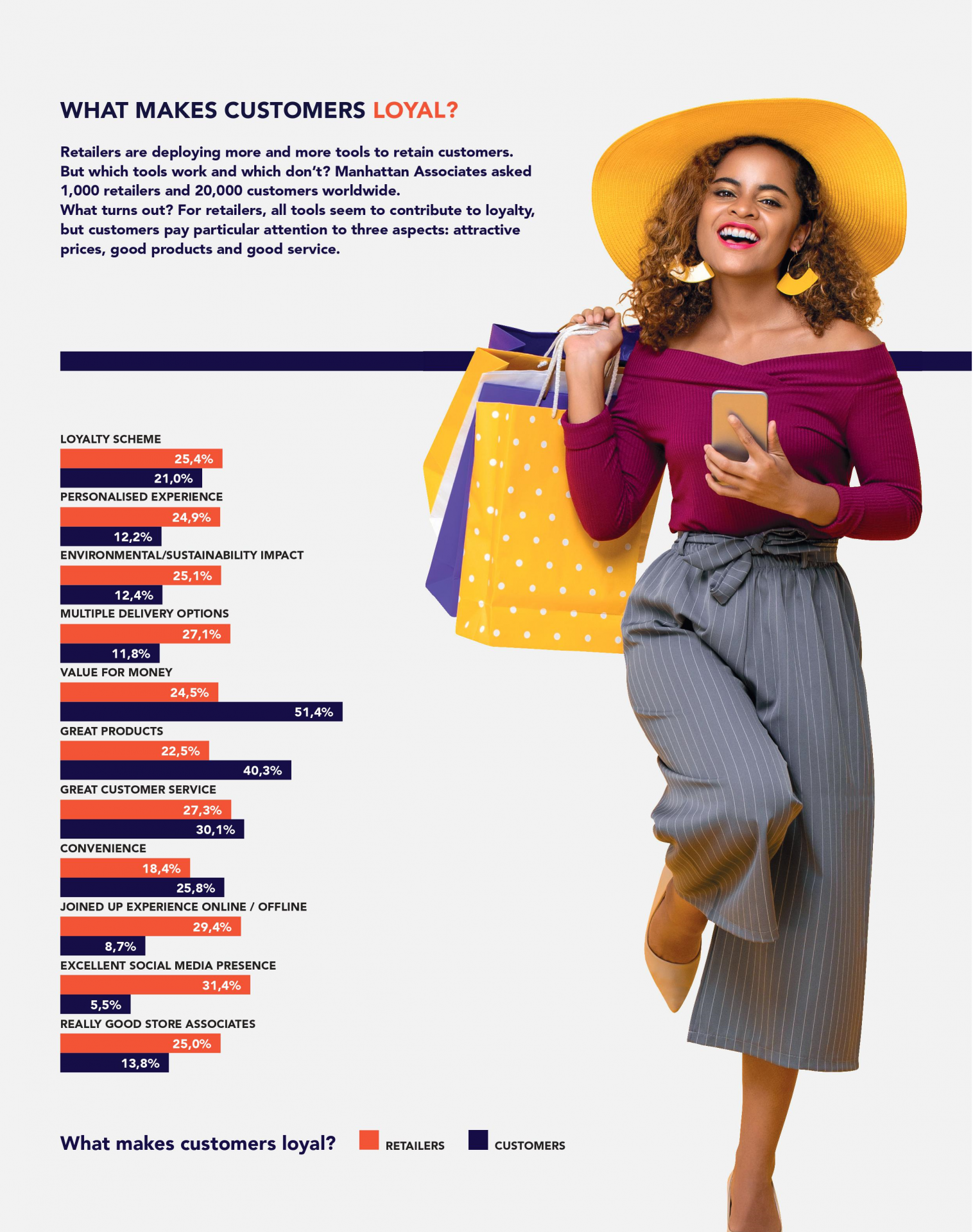COVID-19 has accelerated existing trends in commerce and supply chain. The companies that emerge victorious from the crisis will be those that have been able to respond quickly and adequately to these trends. Cloud technology will become indispensable for this, expects Henri Seroux, Senior Vice President EMEA of Manhattan Associates. “We have probably witnessed a few years of change in just a few months and I believe this change is permanent.”
This spring, the Portuguese Continente switched to a new warehouse management system in its main distribution centre. A few days after go-live, the food retailer (part of the Sonae Group), processed more than twice as many goods as during the highest peak the previous year.
Henri Seroux has many more of these kinds of stories about customers. “There is in every retailer’s mind now a permanent need to be able to adjust execution volumes instantly,” says the Senior Vice President EMEA of Manhattan Associates from his home office somewhere in the French countryside.
“Retailers have established extensive planning processes in recent years. They meticulously map out the demand and fine-tune the supply. The result is a supply chain that can deliver with the precision and predictability of a clock. But that super plan was worth nothing this spring. The demand exploded completely and no longer corresponded in any way with the equally disturbed supply and flow of goods.
“The complete disruption in demand and supply forced retailers to scrap their meticulous plans and focus almost entirely on execution. This meant dealing as effectively as possible with the demand and supply that arose and increasing capacity by deploying extra order-pickers and extra trucks where necessary.”
"During the quarantine period, Kendra Scott, who already ran their unified commercial processes on Manhattan Active Omni, were able to mobilise the inventory of their closed stores in just nine days by launching curbside pick-up."
Using store inventory
In addition to food retail, turnover in ecommerce also grew rapidly. “In a few months, volumes have grown at rates that would otherwise have taken two or three years to recognise. In some sectors the acceleration was even as much as four to six years,” says Seroux, recalling conversations with retail leaders who hoped that online sales would grow to 10 or 15 percent of sales in a few years. “It sounded like a huge achievement to them. Some of those retailers are now deriving half of their sales - even after their physical stores reopened - from online marketplaces.”
Manhattan Associates received emergency calls from retailers who needed help with the execution. “That’s the area we’re in. We help companies optimise execution and flexibly deal with variation and deviation in demand and supply. The emergency calls came from companies looking for ways to increase order processing capacity; using store inventory to ship online orders or turning shops into pickup points, especially at times when stores were forced to close down.
“Retailers saw opportunities to boost sales and reduce the direct impact of the pandemic on their sales pipelines. Some customers only opened their stores for staff, such as DIY retailer Leroy Merlin in France, Italy and Spain. They were able to deliver in their parking lots, picking straight from the stores those badly needed do-it-yourself products. Flexible supply chains and customer services effectively met modified demand headon in 2020.”
From page five issue to front page headline
This is not a temporary effect, but a permanent one, Seroux emphasises. Many retailers and brands continue to process ‘Black Friday’ or ‘Cyber Monday’ volumes, day after day, even after the reopening of the stores. “The crisis has accelerated a significant change in consumer behaviour. Consumers who previously had little experience with ecommerce have now experienced its convenience and efficiency firsthand and I believe this change is here to stay because it was already happening, albeit at a much slower pace.”
The unexpected and rapid growth in ecommerce is putting pressure on supply chains to deliver increased volumes in line with customer expectations. “Companies will have to build new facilities for this. They will have to automate and robotise existing facilities to meet increased demand. And sometimes they will have to switch software systems, now that ecommerce has suddenly become the norm for many (if not most) consumers.”
The pandemic has accelerated the need to mobilise the store - as well as other new services - to serve the consumer better, more rapidly and more conveniently with concepts such as curbside pick-up which utilises the store inventory far more efficiently.
"The difference between success and failure can be as little as five percent, technology like cloud-native applications or microservices architecture can make that difference."
Commitment to the cloud
The crisis has strengthened Seroux’s conviction that Manhattan’s full focus on cloud solutions has been the right one. Previously, Manhattan Associates had already launched a fully cloudbased omni-channel solution, Manhattan Active® Omni. This year, a completely re-invented warehouse management system was added, Manhattan Active Warehouse® Management. Seroux advises companies to rely on the cloud and invest in it. “The latest generation of cloud solutions delivers exactly what companies need in a crisis such as this: unlimited elasticity, agility and speed. Companies don’t have to buy extra hardware when volumes double, it’s already there. If you want to benefit from innovation, you don’t need to upgrade the system first. New functionality is (almost) immediately available.” Seroux again tells a customer story: “What happens if your central distribution centre has to shut down for quarantine reasons? Because that is exactly what happened to the American jewelry retailer Kendra Scott. The team at Kendra Scott were already running their unified commercial processes on Manhattan Active Omni, so they were able in just nine days to mobilise the inventory of their closed stores to fulfill and ship the online orders.”
Thanks to Manhattan’s updated R&D roadmap for Manhattan Active Omni, the functionality that retailers needed during the crisis - such as curbside pick-up - was made available in an accelerated way with the latest version that was introduced halfway through the lockdown. “Customers using the cloud version only need to enable this functionality to benefit immediately. Cloud native technology can help increase flexibility and agility in execution as we saw in this case.”

Shifting proportions
Not everyone is able to take advantage of the opportunities offered by the crisis. Seroux realises that while COVID-19 is hurting traditional business models of retail hard, the impact of the crisis depends, among other things, on the life cycle of products. “Especially in fashion, three months is a long time. Many fashion retailers have missed almost an entire season and are struggling with excess stocks. This disruption brings retailers with an oversized network of stores into immediate trouble. They suddenly have to take drastic measures to survive.”
There are however sectors that benefited from the disruption, such as food retail. Seroux knows stories of food retailers who are worried because they have only been able to attract a small part of the growing online turnover in food retail in recent months. “They have lost market share in the online channel to pure players, simply because they could not respond quickly enough to the changed situation. That leads to concerns, because the online channel is clearly here to stay now.”
No one can predict what’s going to happen in the next few months. Nobody saw this crisis coming and the end of it is not yet in sight. At the same time, other trends, such as the growing focus on sustainability, remain as topical as ever. Consumers are increasingly demanding products, especially in food, that have been produced with more respect to the environment in general. “This does not necessarily mean that these products are produced locally, but it does mean that consumers are increasingly insisting that brands have to take a critical look at the processes, packaging and carbon footprint associated with the products they provide. If companies have a short supply chain because they put everything in an airplane, that gives them a lot of agility and flexibility. But these products do come with a far higher environment cost – one that increasing numbers of consumers (especially younger ones) are not willing to pay.”

"There is in every retailer's mind now a permanent need to be able to adjust execution volumes instantly."
The last five percent
Now that dust is beginning to settle, companies are starting to look to the future again. But, how should they organise their supply chains to become more resilient and better able to manage future disruptions?
Many stories have appeared in the press calling for production to be brought back to Europe, but Seroux doesn’t necessarily believe that is the silver bullet. “Globalisation has given consumers in Europe and elsewhere a lot of purchasing power. The costs of buying a sweater, sofa or TV set are comparatively much lower than about thirty years ago. It’s an illusion to think that we can reclaim production on a large scale in order to start production here at much higher costs, just to minimise the risks and guarantee the supply. “But that doesn’t mean we shouldn’t take measures to reduce our dependency on say one country, for example. We will have to diversify our supply chains and this diversification will in turn increase resilience. But fear not, this isn’t something that will just happen over-night, we’re talking about gradual, longer-term changes,” Seroux explains.
Every retailer or brand has to make its own trade-offs. “They will have to ask themselves how they should solve dilemmas: shorter and faster supply chains offer the benefits of quicker cycles to adjust to demand, but could also come with higher economic and environmental prices. Everything will have to be more flexible including inventory deployment. We will have to integrate our transportation, warehousing and unified commerce systems to be more agile and efficient.”
“Is technology such as cloud software absolutely necessary to withstand these kinds of disruptions? After all, there are retailers, especially in the grocery space who have managed to keep their supply chains running and their shelves fully stocked, without having entirely cloud-native solutions in place. What I would say, is that in situations where the difference between success and failure can be as little as five percent here or a couple of percentage points there, technology like cloud-native applications or microservices architecture can make that difference.”
















Reacties 0